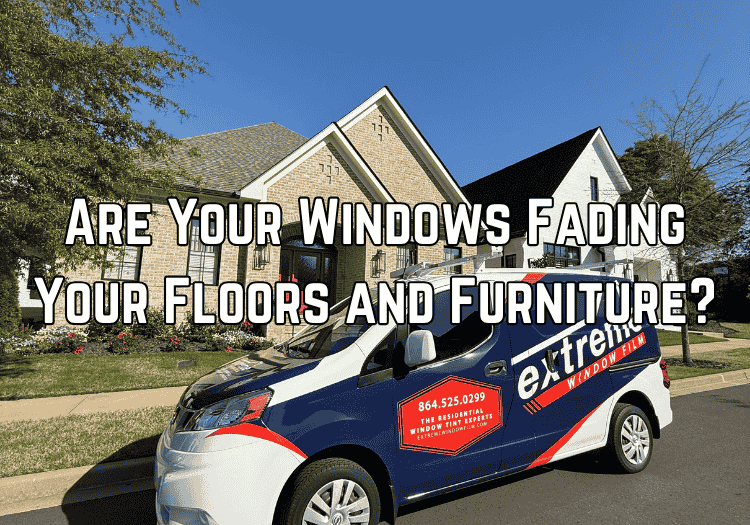If your hardwood floors, rugs, or couch seem dull or patchy over time, your windows could be the reason.
Direct sunlight, especially in sunny areas like the South, can fade, bleach, and break down your interior surfaces. The problem is more common than you might think and isn’t limited to older homes.
Let’s break down why fading happens, what causes it, and how professional residential window film protects your home from sun damage without living in the dark.
Key Takeaways
- UV rays are the main cause of fading in flooring, furniture, and artwork.
- Visible light and heat also contribute to interior damage.
- Window film blocks up to 99% of UV rays and reduces heat and glare.
- Fading happens slowly but once it occurs, it’s permanent.
- Protecting your space now saves money on future repairs or replacements.
Why Do Floors and Furniture Fade?
What Causes Fading?
Fading is mostly caused by sun exposure. When light passes through your windows, it doesn’t just light up your home, it breaks down materials over time.
There are three main culprits:
| Source | Contribution to Fading |
| UV rays (ultraviolet light) | Up to 40% – Most damaging |
| Visible light (what you see) | 25% – Accelerates wear |
| Solar heat (infrared light) | 25% – Causes expansion/contraction |
The rest comes from factors like humidity, indoor lighting, and poor air circulation.
Common Surfaces That Fade
- Hardwood floors: Lose color and finish
- Carpets & rugs: Patchy, uneven wear
- Couches & chairs: Fabric becomes brittle or discolored
- Artwork & photographs: Images fade or yellow
- Wood furniture: Finish breaks down and looks washed out
If you’ve ever moved a rug or rearranged furniture and noticed lighter areas underneath, that’s photodegradation, a slow breakdown from light exposure.
How Fast Does Sunlight Cause Damage?
It doesn’t happen overnight, but the damage builds up daily.
- Within 6 months: Early signs like dulling or light patches
- After 1-2 years: Noticeable fading or bleaching
- After 5+ years: Irreversible damage and possible material breakdown
Homes with large south- or west-facing windows are hit the hardest, especially in climates with long, sunny days.
Can Window Film Really Prevent Fading?
Yes, quality window films are one of the best ways to stop fading before it starts.
How Window Film Helps?
Understanding how window film works helps explain its protective benefits. Window film is a thin, transparent layer applied to your existing windows. It’s barely noticeable but extremely effective.
Here’s what it does:
- Blocks 99% of UV rays (the main culprit of fading)
- Reduces heat to limit temperature stress on materials
- Cuts glare from sunlight that strains eyes and screens
- Preserves natural light so that your room stays bright, not cave-like
Comparison: Untreated Glass vs Window Film
| Feature | Untreated Glass | With Window Film |
| UV protection | 25% or less | Up to 99% |
| Heat reduction | Minimal | Up to 80% |
| Visibility | High | High (no dark tint needed) |
| Interior fade risk | High | Low |
Window film is also a cost-effective alternative to replacing windows with low-e (low-emissivity) glass.
Other Ways to Protect Your Interiors (But With Tradeoffs)
Window film isn’t the only solution, but others come with drawbacks:
Curtains and Blinds
- Block light entirely, making rooms darker
- Don’t block UV rays fully, especially if they’re thin or light-colored
- Not ideal if you like natural light
UV-Coated Glass
- Works well, but expensive to install
- Usually found in newer builds, not older homes
- Replacing glass = higher labor costs
Moving Furniture Around
- Prevents uneven fading
- But doesn’t stop overall damage
- Inconvenient for layout or design
Protective Coatings on Furniture
- Temporary help for fabric and wood
- Doesn’t protect floors, rugs, or art
- Needs re-application every few years
What to Look For in a Good Window Film?
Not all films are created equal. Here’s what to check:
- UV protection rating: Look for 99% or more
- Infrared rejection: Reduces heat, ideally 60-80%
- Clarity: High-quality films are nearly invisible
- Warranty: Most good films come with 10-15 year warranties
- Certified installer: Proper installation is key to performance
Window film works for residential and commercial properties alike, protecting both homes and businesses.
Don’t Wait Until It’s Too Late
By the time you see fading, the damage is already done.
Installing window film now helps:
- Preserve your interiors
- Extend the life of your flooring, furniture, and decor
- Lower energy bills (thanks to heat rejection)
- Maintain natural light without harsh UV damage
Final Thoughts
Sunlight is great until it starts destroying what’s inside your home or office. Window film works equally well on dual-pane windows when properly installed.
Fading is silent but permanent. It happens a little each day, and you don’t notice it until the damage is done.
The good news? You can stop it. And window film is one of the most practical, affordable, and long-term solutions out there.



